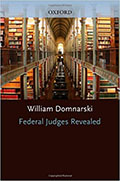responses from
members of the federal judiciary, trial and appellant (but not the Supreme
Court) in the telling of their stories, it becomes apparent to anyone who has a
basic knowledge of how courts function that the lives of these judges probably do not differ significantly in many
aspects to those in the state judiciaries of the United States or judges from
other countries. For that reason this is a book that can be beneficial to
judges everywhere.
There are parts of the book that would be of more interest
to judge/lawyer readers than others. The author has a lengthy section on “Life
Before Admission to the Bar” which contains accounts by a large number of
lawyers about their college and law school days. These accounts are probably
of marginal interest to readers except to focus on the fact that sitting judges
have attended a variety of colleges and universities. One part of this chapter
seems to be devoted to judges who went to Harvard Law School, which seems to
place too much emphasis on that school and to suggest that it offers an
advantage over other law schools for those planning a judicial career. Elite law school backgrounds tend to assist those seeking a federal appellate judgeship as opposed to a district (trial) court appointment.
The chapter on “Judicial Appointments Recounted” (Chapter
Three) would be of special appeal and assistance to those lawyers or state
court judges who are undergoing consideration for a federal judge appointment.
It recounts the process "and the pitfalls that occur during that process".
Other chapters however, focus on matters that would be very
useful to new judges and those that have been sitting for a more extended
period. The three chapters titled successively “Once Appointed, Transition to
the Job,” (Chapter Four) “Nature of the Job,” (Chapter Five) and “In Chambers,
in Court, and Getting Along with Others,” (Chapter Six) offer insights and
comments that cannot be but helpful in determining what actions work and what
don’t work to be a successful judge.
A sample of a commentary by one judge in the chapter on
actions in chambers and in courts is instructive about the kinds of viewpoints
that appear in these chapters. This observation is taken from an oral history
by a U.S. district judge from Idaho, on the subjects of “the way judges manage
their work in chambers, while another is to look at how judges manage what they
do in court, which includes how they handle the lawyers practicing before
them.” The judge in his oral history made the following observation:
You learn to use your law clerks, you use your
secretary, everyone’s around that can be helpful on this, you learn to
put them to the highest and best use. Then on top of that you learn to
use your attorneys in asking for the briefs and for all the help
you can get out of the attorneys, and they’re more than willing as advocates
to do everything they can to serve their side of the
case.
The three chapters referred to above are filled with similar
observations from the judges who were interviewed about how they viewed their
jobs, the actions they took and, the activities they engage in. These narratives
will provide helpful advice to lawyers who want to become judges, and those who
are already embarking on a judicial career.
William Domnarski has provided the bench and bar with a
valuable volume which can enrich their knowledge about how the U.S. legal system
works and contributes to rule of law principles which support that system.

 International
Judicial Monitor
International
Judicial Monitor